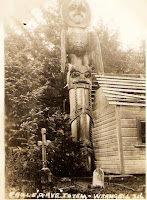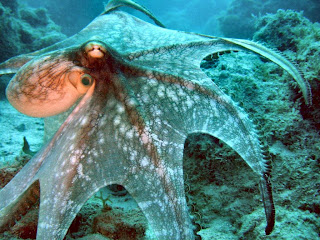This time of year we give thanks for what we have. I'm reminded that a favorite Southeastern Alaskan food that we enjoy during the fall and winter is harvested in the spring: herring eggs. Herring eggs are a part of our eveyday and ceremonial life. Often a Thanksgiving dinner includes herring eggs.
*This piece originally appeared in Alaska Women Speak.
 |
| Photo courtesy of Roby Littlefield |
I am with my husband and four children in an aluminum skiff near an island outside of Sheet’ká Kwáan, Sitka, Alaska. We are looking for the best place to set out our hemlock branch. Using a long rope, we tie off the hemlock branch from a larger tree on the beach. This is the same technique that my husband's and my children's Tlingit ancestors have used for thousands of years. With our skiff, we tow one end of the long rope with the hemlock branch attached out into the ocean. We leave the branch to bob and sway in the water, letting the tide flow in and out, enticing the herring who'll lay their eggs on the delicate hemlock needles.

While the tree is soaking, my children and I walk the beaches on the small island, pulling herring eggs off the rocks and eating them. I put the herring eggs into my youngest daughter's mouth. She chews and smiles at me. Around us, flocks of shore birds and eagles share in the harvest. Some of these gull-types are clan-family: the black-legged kittiwakes. We walk the forest edge and I place my hand on an old spruce tree.
"Feel the bark," I say to my oldest daughter. She touches it then bends in to sniff it. Next, I walk over to a hemlock tree. "Now, feel this one," I say.
 She rubs her fingers across its bark. This daughter, my oldest child, is the one I've chosen to remember our stories. So I tell her a story about how Beaver and Porcupine were friends. One day, Porcupine invited Beaver to his house. A bear frightened them up a tree and when the coast was clear, Beaver climbed down leaving long striations in the treebark with his claws.
She rubs her fingers across its bark. This daughter, my oldest child, is the one I've chosen to remember our stories. So I tell her a story about how Beaver and Porcupine were friends. One day, Porcupine invited Beaver to his house. A bear frightened them up a tree and when the coast was clear, Beaver climbed down leaving long striations in the treebark with his claws.
 |
| Photo courtesy of Roby Littlefield |
Now, we have participated in the ritual of man and nature, story and family. The old stories carry traditional knowledge. I say to my daughter, "You can recognize hemlock bark because of its long striations going down the length of the tree—these are the marks left by Beaver."
After a picnic lunch on the beach, we climb back into the skiff and head to where the hemlock branch is soaking. We haul it into the skiff, heaving it over the gunwale. Thick herring roe dangles from the branches. Our elders view the herring roe as a sign of life continual. In the spring, after the herring have spawned in the Sitka region, herring eggs are distributed to the smaller villages like Hoonah and other communities in Southeastern Alaska. Much of the roe is saved for memorial parties in the fall. Before we take our share home, we distribute herring eggs to relatives and friends.
 |
| Photo courtesy of Roby Littlefield |
At home, we treat ourselves to herring eggs blanched in boiling water. The eggs remain on the smaller, thin-needled branches. We sit around our table. A large bowl brims with eggs. I've made a salad with the last package of beach greens that I'd put up for the winter: goose tongue and beach asparagus. We eat herring eggs with soy sauce or with bits of black seaweed sprinkled on top. We dip them in seal grease and the grease drips off our chins. We tell the story of our day, creating new stories. We recall the chop on gray water, the pungent smell of roe, the deafening sound of hungry gulls; and the elder's face when she opened the door to find my youngest handing her a bag of herring eggs. This is our ceremony.
 She rubs her fingers across its bark. This daughter, my oldest child, is the one I've chosen to remember our stories. So I tell her a story about how Beaver and Porcupine were friends. One day, Porcupine invited Beaver to his house. A bear frightened them up a tree and when the coast was clear, Beaver climbed down leaving long striations in the treebark with his claws.
She rubs her fingers across its bark. This daughter, my oldest child, is the one I've chosen to remember our stories. So I tell her a story about how Beaver and Porcupine were friends. One day, Porcupine invited Beaver to his house. A bear frightened them up a tree and when the coast was clear, Beaver climbed down leaving long striations in the treebark with his claws.

 She rubs her fingers across its bark. This daughter, my oldest child, is the one I've chosen to remember our stories. So I tell her a story about how Beaver and Porcupine were friends. One day, Porcupine invited Beaver to his house. A bear frightened them up a tree and when the coast was clear, Beaver climbed down leaving long striations in the treebark with his claws.
She rubs her fingers across its bark. This daughter, my oldest child, is the one I've chosen to remember our stories. So I tell her a story about how Beaver and Porcupine were friends. One day, Porcupine invited Beaver to his house. A bear frightened them up a tree and when the coast was clear, Beaver climbed down leaving long striations in the treebark with his claws. 




Comments